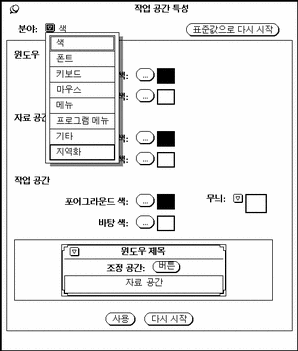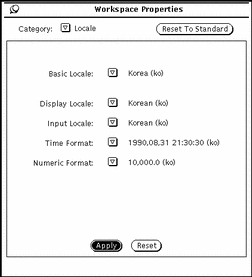Starting Up OpenWindows
Checking Your User Environment
Before you log in, your system administrator should have set your required user environment variables and corresponding entries in the .cshrc file in your home directory. These system environment variables are essential to using Korean features.
.cshrc File
These system environment variables might not have been set. So the first time you log in, before you start up OpenWindows for the first time, check to make sure lines like the following are in the .cshrc file in your home directory:
setenv LANG ko setenv OPENWINHOME /usr/openwin set path=( /usr/SUNWale/bin $OPENWINHOME/bin $path ) ... if ($?USER != 0 && $?prompt != 0) then /bin/stty cs8 -istrip defeucw endif |
Make sure the LANG variable is set to C (ASCII) or ko (Korean) before the if...endif statement and that no prompt is set before the if...endif.
If these lines are not present or are different, contact your system administrator. If you are your own system administrator or an advanced user, refer to Korean Solaris System Administrator's Guide for further information on setting up your Korean Solaris system.
.openwin-init File
If you have a .openwin-init file in your home directory and might use the Korean character input facilities, check this file for the presence of an htt command, as described in "How and When htt is Started" on page 15.
.xinitrc File
If your system has a .xinitrc file in your home directory, check and make sure it contains at least the lines provided in Korean Solaris $OPENWINHOME/lib/Xinitrc file.
Starting the Korean OpenWindows Environment
After you verify that your .cshrc file has set your user environment correctly for Korean language operation, you are ready to start up your Korean OpenWindows environment as follows:
Type the following command at the system prompt to start up the Korean OpenWindows environment:
system% openwin |
Changing the Language Setting on the Workspace Properties Worksheet
The Korean OpenWindows Workspace Properties worksheet contains a localization field. To change the language setting for the next OpenWindows tools you start:
-
Choose Properties... on the main window Workspace menu.
-
Choose the Locale category on the Category pull down menu.
The English form of the Workspace Properties worksheet is on the left and the Korean form is on the right:


You can set the display and input mechanisms of the Korean OpenWindows environment by using the Locale field in the Workspace Properties worksheet. You can switch between the U.S. and the Korean settings.
The Locale setting determines which characters (ASCII, Korean) appear in new tool windows when they start up. Changing the locale does not affect the appearance or operation of tool windows that were started up before the change.
Changing Your System Locale Setting
To change the Locale setting on the Workspace Properties worksheet (and in the .OWdefaults file as explained in Korean Solaris System Administrator's Guide):
-
Access the Workspace Properties Locale worksheet.
-
Change the Locale setting by choosing U.S. or Korea on the Basic Locale menu.
The English version of this menu is on the left and the Korean version is on the right. (In this example the Korean locale is selected.)


-
Click the Apply button to set the locale on the system.
The English version of this menu is on the left and the Korean version is on the right.


Clicking Apply then applies these settings, overwriting your current .OWdefaults file. The information in this file is the start-up settings OpenWindows uses to start up your applications. For explanations of the contents and functions of the .OWdefaults file, refer to Solaris Internationalization Guide for Developers and Korean Solaris System Administrator's Guide.
- © 2010, Oracle Corporation and/or its affiliates
